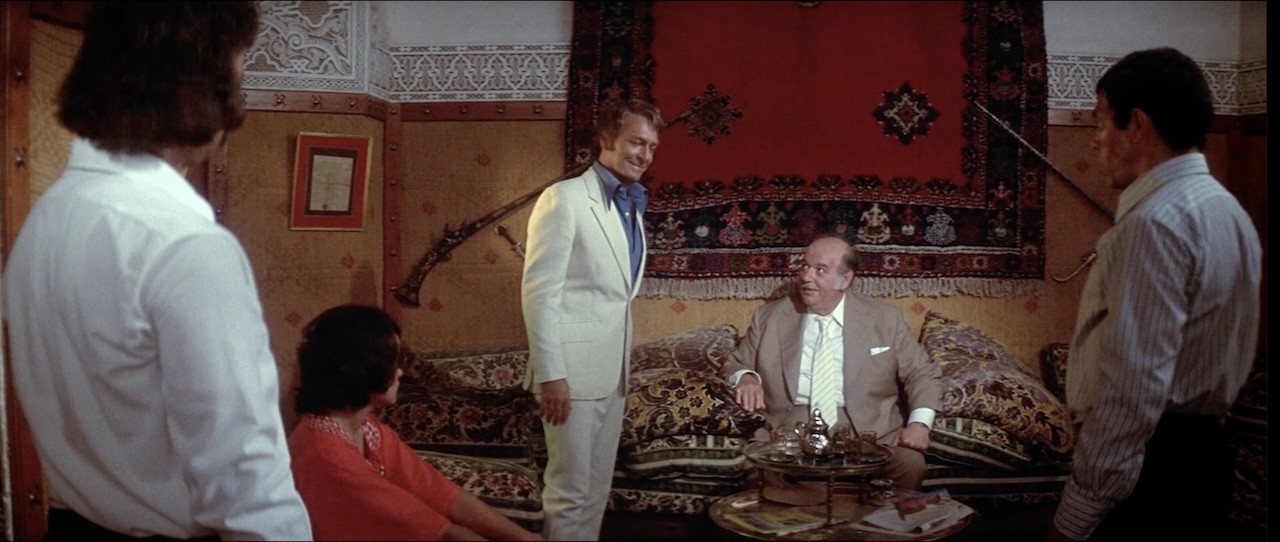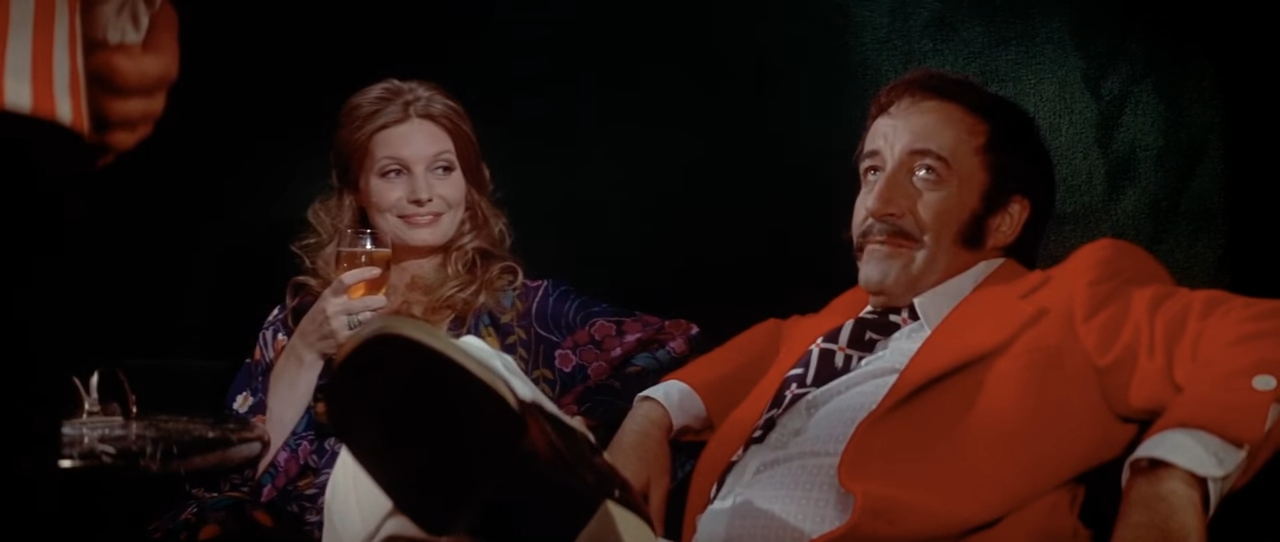
The Return of the Pink Panther (1975) is the third of the Clouseau movies with Peter Sellers, but it’s also a pretty good heist movie in the tradition of Rififi, Topkapi, and Grand Slam. That the first Pink Panther belonged to the same tradition was overshadowed by Sellers’ performance as Clouseau; David Niven was supposed to be lead and Sellers stole the picture from him. The second film, the hilarious A Shot in the Dark, was a pre-existing crime drama with the Clouseau character grafted on to capitalize on the success of the original film.
The movie opens with the theft of the titular Pink Panther, a fabulously valuable jewel, from a museum in Lugash. The heist is patterned on the heists in Rififi and Topkapi, right down to the iconic Henry Mancini score disappearing at the climax. In response, the authorities in Lugash take the fateful decision to call in the famous inspector who recovered the jewel in the first movie. Meanwhile, relaxing at his villa in Nice, retired jewel thief Sir Charles Litton realizes that he’s being framed and that it’s up to him to catch the real thief first.
From here we proceed with two movies in parallel, occasionally overlapping: a heist caper built around Christopher Plummer’s Litton, as he tries to find out the truth and save his skin; and a comic farce featuring Sellers’ ludicrous attempts to conduct an investigation. Both work well and support each other.
The supporting cast is a who’s-who of 1970s character actors. Herbert Lom, André Maranne, and Burt Kwouk are back from previous installments as Chief Inspector Dreyfus (Clouseau’s exasperated boss), François (Dreyfus’ chief of staff), and Kato (Clouseau’s live-in servant/tackling dummy). In the heist caper we have Eric Pohlmann and Graham Stark as members of Lugash underworld; and Peter Jeffrey and Peter Arne as part of the Lugash security apparatus. In the comic farce are Catherine Schell as Sir Charles’ wife and David Lodge (who had a different role in A Shot in the Dark) as Sir Charles’ majordomo. Victor Spinetti (from both A Hard Day’s Night and Help!) is a hotel manager, and John Bluthal has a cameo as an ostensibly blind lookout for a bank gang. Keen-eyed Star Wars fans will recognize Claire Davenport as Lady Litton’s masseuse; she played one of the dancers at Jabba’s Palace in Return of the Jedi.

Plummer plays Litton as a charming rogue; his scenes with Pohlmann at the latter’s nightclub in Lugash anticipate James Bond’s visit to Max Kalba in The Spy Who Loved Me in 1977.[1] His principal adversaries are Colonel Sharki (Arne), chief of the Lugash secret police, and Pohlmann (the “Fat Man”), standing in for Sydney Greenstreet as the head of all criminal activities in Lugash. Plummer is only two years younger than Roger Moore but he looks younger still; on the strength of this movie he would have made a decent Bond. He’s charming, but with an edge.
Sellers does Clouseau shtick rather well this time out: the deliberately bad French accent, funny grammar, convoluted logic, and inexplicable difficulties with common mechanical devices. After some encounters in Nice, Clouseau follows Lady Litton (Schell) to Gstaad in Switzerland, searching for her husband and making a half-assed attempt to seduce her. Catherine Schell is effortlessly charming and delightful; lore has it that she couldn’t help laughing at Sellers’ antics, so it was written into her character. The dialogue crackles. The bit where Sellers goes full lounge lizard and says “Here is looking at you, kid” to a visibly amused Schell never gets old.

The action converges in Gstaad as the pursuers converge on their prey. Litton on his wife, having realized that she stole the jewel to break him out of his lethargy. Sharki, on Litton, because Litton reneged on certain promises made in Lugash. Clouseau, on the Littons. And, finally, a deranged Dreyfus on Clouseau. The final encounter in Lady Litton’s hotel room is a beautiful comedy of errors. It’s also the only time Sellers and Plummer are on screen together, and that’s probably for the best. Plummer and Sellers aren’t really in the same movie.
Make no mistake, this is as much Plummer’s movie as it Sellers’. His parts are just as fun, just as engaging, and made with as much flair. Morocco stands in for Lugash and wasn’t just relegated to second unit work. Unlike A Shot in the Dark, or The Pink Panther Strikes Again afterwards, Plummer winds up with the girl (his wife), not Clouseau. It’s easy to imagine Plummer’s half of the movie being expanded to a standalone feature, though it would lose the madcap energy that Sellers brings to the table. I have to wonder if director Blake Edwards was conscious about not letting Sellers upstage Plummer, as had happened in the original Pink Panther with Niven.
There are more than passing similarities between the Lugash sequences in this movie and the Egyptian sequences in The Spy Who Loved Me. ↩︎